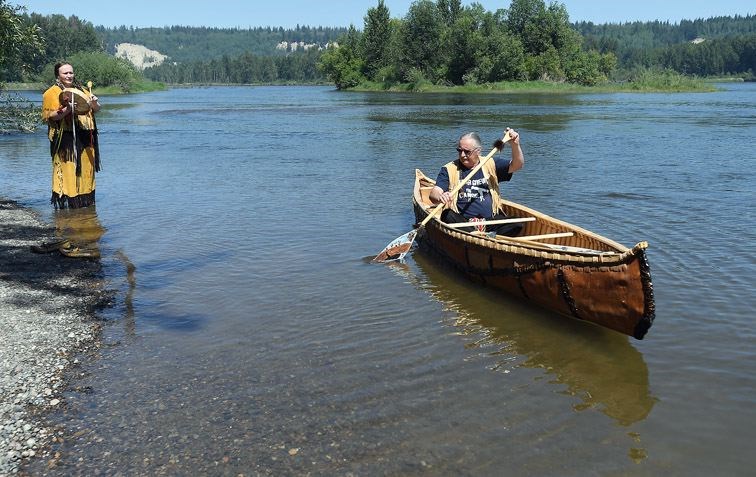For Lydia Toorenburgh, it is a symbol of a cultural journey completed.
The visiting student from the University of Victoria, along with seven others from UNBC, watched in fulfillment as a birch bark messenger canoe was welcomed with traditional song and drumming as it made its way into the Nechako River on Wednesday afternoon.
The official launch of the canoe came after three months of construction as part the Canada 150 project and a partnership between UNBC, Le Cercle des Canadiens Francais de Prince George and Two Rivers Gallery with a grant secured from Heritage Canada.
"My daughter is offering a song to open this and my son is handing out tobacco to offer to the river, to appreciate that we still have water today," said canoe construction instructor Marcel Labelle.
For the students taking part in the experimental learning field school, the ciman (canoe in Cree) stands as a symbol of revived cultural identity, the value of teamwork and a shared history of Metis culture.
"For myself, I come from a Metis background and my family has lost much of their heritage," Toorenburgh said.
"I can now incorporate what I have learned about my history and culture and I now have a responsibility to take it back home to my family."
For fellow student Wayne Nipshank, building the canoe as a team is what made the project such a great success.
"The big thing is culture and bringing it back to its roots. It's not about the individual as much as it is about working together," Nipshank said.
Students involved with the project combined classroom teaching about Cree/Metis culture and the history of French speaking people in northern British Columbia.
"If you were to go back in time, back to 1867, the language spoken in these areas would have been French with the fur trading happening.
"It's important that we recognize the contributions made by these French speaking men as they canoed from fort to fort," said UNBC anthropology professor Michel Bouchard.
"We are also thankful for the partnerships made. This is a nice example of community coming together and sharing in a nice result."
The field school consisted of three courses, two of which were in classroom and the last at Two Rivers Gallery where the canoe was constructed.
Labelle, an expert birch bark canoe builder, modeled a T-shirt reading "Never give up. You canoe it."
Labelle had students learn every step of the hands-on portion of the class including finding roots to attach parts of the canoe together, stitching the birch bark and sealing the canoe with spruce gum.
Just before the canoe entered the water for the first time, a feather made its way around it in traditional ceremony by Metis elder Earl Henderson.
"This feather will protect the canoe wherever it may go," Labelle said.
"This canoe comes from all of the materials from mother earth. And it always finds its way back to nature."
All students received Metis sashes in recognition of completion.
Henderson, a Metis elder and UNBC instructor taught the class on Cree and Metis culture and also assisted with the canoe's construction.
"Out of the eight students, six were Metis", Henderson said.
"It was an honour to see them take part in this, as part of our culture."



